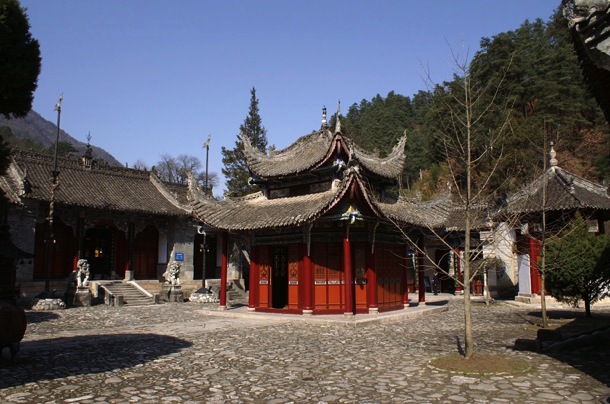|
FEATURES
Temple of Marquis Liu 留侯祠 | China Heritage Quarterly
The Temple of Marquis Liu, Shaanxi
陕西留侯祠
Sang Ye with Geremie R. Barmé


Tradition holds that the Temple of the Marquis of Liu marks the spot where Zhang Liang 張良 (d.186BCE), Marquis of Liu, a strategist and hero of the Han Dynasty is said to have lived in reclusion. The temple building seen in the centre of Boerschmann's image is the Hall of the Efficacious Official (Lingguan Dian 靈官殿), which was built during the Ming dynasty (1368-1644).[Fig.1] The present hall dates from the 1980s, when it was reconstructed. It is evident from the more recent picture that considerable changes have been wrought to the rest of the grounds as well.[Fig.2] Located in Liuba County, Hanzhong, Shaanxi province 陝西省漢中留壩縣, it is also more popularly known today as Zhang Liang Temple (Zhang Liang ci 張良祠).
The 85-year-old Mr Jiao 焦先生 has lived near the Temple of the Marquis of Liu for his whole life. He ran a photographic stall there from the 1940s until the 1970s. 'The temple is quite a distance from the city,' he recounted:
So they left it alone even during the destructive phase of the Cultural Revolution when they were destroying the Four Olds. It might have escaped unscathed except for a foolish rumour. Someone claimed that the temple was actually a shrine devoted to political restoration. They said that, before he fled to Taiwan, Generalissimo Chiang Kai-shek had sent someone to bury a formal portrait of him wearing his presidential uniform at the temple. Because the place is supposed to have such spiritual power, Chiang thought that leaving [liu 留—the same word as used in the name 'Marquis of Liu'—translator's note] his picture here would help him return to rule on the mainland. Then he could have it unearthed and hung in the Presidential Palace. Of course, this was quite ridiculous, but the Red Guards believed it, as did other older better-educated people who should have known better. Even the local Party Secretary believed it.
So, one day, eight lorries brimming with people drove out here. Some were Red Guards but the majority were teachers and cadres with the Party Secretary. They'd come to 'carry out revolution'. They felt they to dig up the whole temple to find and get rid of that portrait of Chiang Kai-shek. They dug three feet down looking for it, hopeful they could dispel the malign influence of Chiang and bring good fortune to Chairman Mao. Though they didn't find the picture, they succeeded in undermining the old temple and it collapsed.
After the Cultural Revolution, the authorities declared that the Red Guards had been deceived and that local cadres were guilty of destroying cultural relics. The Party Secretary fearful that he'd end up in jail committed suicide. He really never understood how things work. His first mistake was to take the revolutionary storm seriously in the first place and to come out here to dig the place up. Later he thought things were more serious for him than they really were, and so he killed himself.
The people upstairs were merely making a big noise to show that they were keeping pace with the changes in policy in the Centre. They would never have thrown him in jail. If only he'd hung on for a few days until things had settled down he would have been in the clear. People who'd murdered others during the Cultural Revolution got away without taking a bullet. Don't you think he just threw his life away?
|